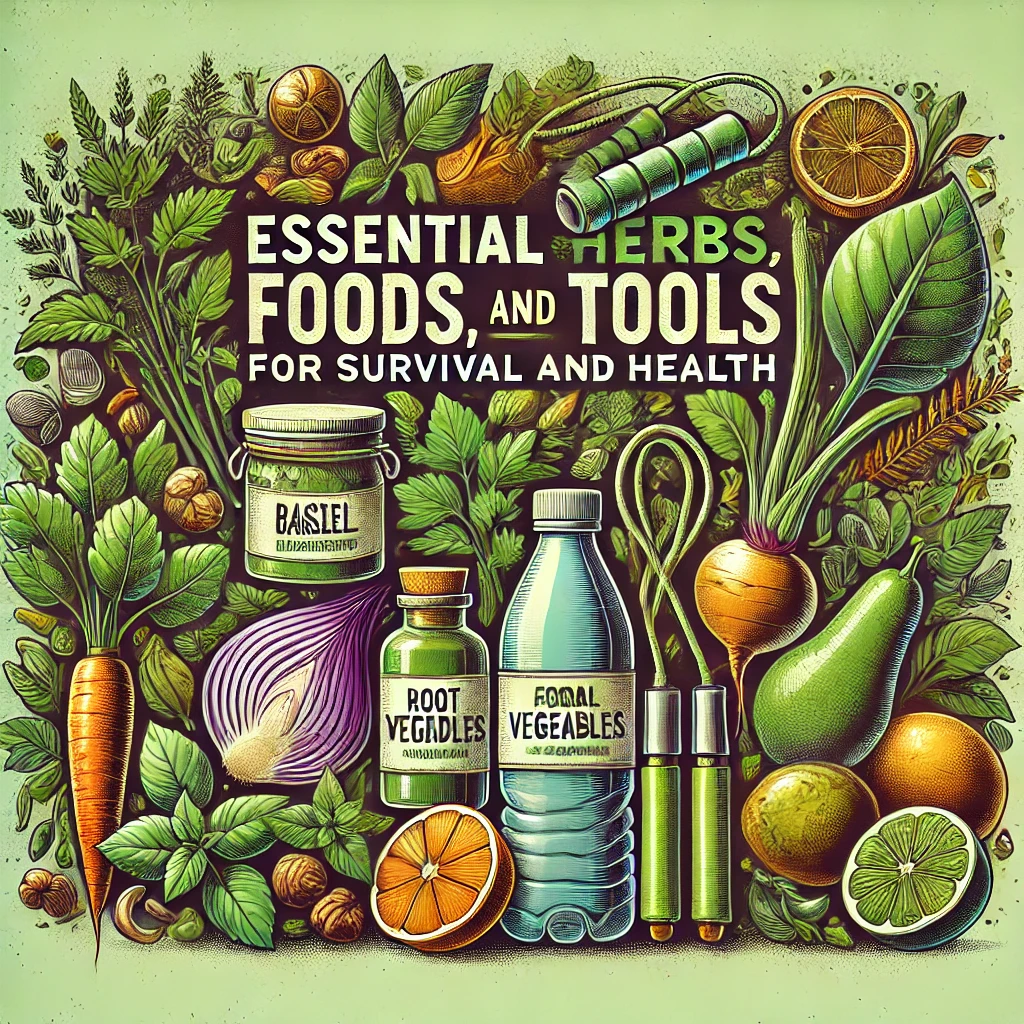Basic Agriculture, Poultry Raising, Fishing, and Livestock Farming Techniques for ITSCS Practitioners
These techniques complement the Integrated Tactical Survival Combat System (ITSCS) by ensuring food security, sustainability, and adaptability under all circumstances. Practitioners should understand these essential skills to maximize survival, efficiency, and the benefits of the system.
1. Basic Agriculture Techniques
Key Techniques:
- Soil Preparation:
- Remove weeds, loosen soil with a hoe or shovel, and mix in compost or organic matter to improve fertility.
- Planting:
- Choose crops based on climate and soil conditions (e.g., root vegetables like carrots for cooler climates, leafy greens for temperate zones).
- Space seeds according to instructions to prevent overcrowding.
- Watering:
- Use drip irrigation or water early in the morning or late afternoon to minimize evaporation.
- Crop Rotation:
- Avoid planting the same crop in the same spot consecutively to prevent soil depletion and pest issues.
- Natural Pest Control:
- Use companion planting (e.g., marigolds to repel pests).
- Make homemade sprays with garlic or neem oil for organic pest management.
- Harvesting:
- Pick vegetables and fruits when ripe to encourage further growth.
- Learn to identify maturity signs for specific crops.
- Composting:
- Collect food scraps, yard waste, and organic matter to create nutrient-rich compost for soil enhancement.
Essential Crops to Grow:
- Staples: Potatoes, corn, rice, wheat.
- Leafy Greens: Spinach, kale, lettuce.
- Fruits: Tomatoes, cucumbers, berries.
- Legumes: Beans, lentils, chickpeas.
- Herbs: Basil, parsley, mint, rosemary.
2. Poultry Raising
Basics of Poultry Farming:
- Housing:
- Build a coop that protects birds from predators and extreme weather.
- Provide nesting boxes, roosting bars, and adequate ventilation.
- Feeding:
- Feed chickens a balanced diet of grains, kitchen scraps, and foraging (worms, insects).
- Provide clean water daily.
- Health Care:
- Check for common diseases (e.g., mites, respiratory issues).
- Use natural remedies like apple cider vinegar in water for gut health.
- Egg Collection:
- Collect eggs daily to prevent spoilage and encourage laying.
- Breeding:
- Keep a ratio of one rooster per 8–10 hens for natural reproduction.
Benefits:
- Eggs and meat provide essential protein.
- Poultry manure enriches compost for gardening.
3. Fishing Techniques
Fishing with a Pole/Rod:
- Equipment:
- Fishing pole or rod, line, hooks, and bait (worms, insects, artificial lures).
- Optional: Floats and sinkers to adjust depth.
- Technique:
- Casting: Cast the line into the water and wait for bites.
- Setting the Hook: When the line tugs, pull gently to set the hook.
- Reeling In: Use a steady motion to reel in the fish.
- Bait:
- Freshwater: Worms, crickets, corn kernels.
- Saltwater: Shrimp, cut fish, squid.
Fishing Without a Pole/Rod:
- Hand Lines:
- Use fishing line, a hook, and bait. Hold the line or tie it to a sturdy stick.
- Spearfishing:
- Use sharpened sticks or spears to target fish in shallow water.
- Fish Traps:
- Basket Traps: Weave a cone-shaped basket with a narrow opening to catch fish.
- Rock Corrals: Build a semicircular wall of rocks in shallow water; fish enter at high tide and remain trapped.
- Netting:
- Use hand-thrown or drag nets to catch multiple fish at once.
- Improvised Rods:
- Materials: A sturdy stick or bamboo for the rod, string or fishing line, a bent pin or nail for the hook.
- Assembly: Attach the string securely to the stick, tie the hook, and bait it.
4. Livestock Farming
Basics of Livestock Management:
- Animal Selection:
- Prioritize hardy animals suited for the environment (e.g., goats, sheep, cows, rabbits).
- Housing:
- Provide shelter from weather and predators.
- Keep areas clean to prevent disease.
- Feeding:
- Use pasture grazing, supplemented with fodder or grains.
- Provide clean water at all times.
- Breeding:
- Select healthy animals for reproduction to ensure strong offspring.
- Health Care:
- Learn to recognize common illnesses and basic treatments.
- Vaccinate animals as needed.
- Manure Management:
- Collect and compost manure for fertilizing crops.
Benefits of Livestock:
- Goats: Milk, meat, and manure.
- Cows: Milk, meat, and hides.
- Sheep: Wool, meat, and milk.
- Rabbits: High-reproduction rate for meat.
How These Skills Complement ITSCS
- Sustainability:
- Agriculture, fishing, and livestock ensure a consistent food supply.
- Adaptability:
- Skills work in diverse environments (wilderness, rural, or urban areas).
- Physical Readiness:
- Physical labor involved in farming and fishing builds endurance and strength.
- Mental Resilience:
- Engaging with nature reduces stress and sharpens problem-solving abilities.
- Team Dynamics:
- Farming and livestock care can be collaborative, fostering teamwork.
By mastering these techniques, practitioners can enhance their survival capabilities while promoting long-term sustainability and resilience.
Advanced Survival Techniques
Advanced survival techniques go beyond basic survival skills, enabling practitioners to handle complex and extreme scenarios. These methods focus on resourcefulness, adaptability, and efficiency in utilizing natural surroundings.
1. Shelter Construction
- Debris Hut:
- Build a framework with sticks and cover it with leaves, grass, or moss for insulation.
- Ideal for cold environments.
- Snow Cave:
- Dig into a snowbank to create a protective shelter in snowy conditions.
- Desert Shelter:
- Use rocks, branches, or tarp to create shade and reduce exposure to the sun.
2. Water Procurement and Purification
- Solar Still:
- Dig a hole, place a container in the center, cover it with plastic, and weigh it down in the middle. Condensation collects in the container.
- Natural Filters:
- Use layers of sand, charcoal, and gravel to filter water.
- Improvised Purification:
- Boil water, use purification tablets, or natural disinfectants like iodine.
3. Advanced Fire Starting
- Flint and Steel:
- Strike steel against flint to create sparks.
- Friction Fire:
- Use a bow drill or hand drill with dry wood to create embers.
- Chemical Fire:
- Combine potassium permanganate and glycerin for instant combustion (requires knowledge of safe handling).
4. Food Sourcing
- Trapping and Snaring:
- Set traps (e.g., figure-four or spring snare) for small animals.
- Edible Plants Identification:
- Learn to identify safe plants, mushrooms, and berries.
- Foraging:
- Focus on nuts, seeds, roots, and edible leaves.
- Fishing Without Gear:
- Use fish traps, spearfishing, or hand-lining techniques.
5. Navigation
- Natural Navigation:
- Use the sun’s position, stars (e.g., North Star), and moss growth (usually on the north side in the Northern Hemisphere).
- Improvised Compass:
- Magnetize a needle by rubbing it against silk, place it on a leaf in water, and it will align north-south.
6. First Aid and Health
- Wound Care:
- Clean wounds with boiled water and apply natural antiseptics like honey or aloe vera.
- Emergency Splints:
- Use sturdy branches and cloth for broken bones.
- Prevent Hypothermia:
- Layer clothing, use body heat, and insulate from the ground.
7. Defensive Strategies
- Camouflage:
- Use natural materials (mud, leaves) to blend into surroundings.
- Situational Awareness:
- Monitor surroundings for potential threats and escape routes.
- Improvised Tools:
- Craft tools or weapons from available resources (e.g., sharpened sticks, slings).
How to Start Gardening
Starting a garden involves basic planning, resource gathering, and proper care to grow your own food effectively.
Steps to Start Gardening
1. Choose a Location
- Sunlight:
- Pick a spot with 6–8 hours of direct sunlight daily.
- Soil Quality:
- Test the soil for drainage and fertility (pH between 6.0–7.5 is ideal).
- Accessibility:
- Ensure it’s easy to water and maintain.
2. Prepare the Soil
- Remove weeds, rocks, and debris.
- Loosen the soil with a hoe or garden fork.
- Add organic matter like compost or manure for nutrients.
3. Decide What to Plant
- Vegetables:
- Start with easy-to-grow options like tomatoes, carrots, lettuce, or beans.
- Herbs:
- Basil, parsley, mint, or cilantro are great for beginners.
- Fruits:
- Strawberries, blueberries, or small fruit trees.
4. Planting
- Seeds vs. Seedlings:
- Use seedlings for quicker results or seeds for cost efficiency.
- Spacing:
- Follow specific spacing instructions for each plant to prevent overcrowding.
- Depth:
- Plant seeds at the recommended depth for proper germination.
5. Watering
- Water deeply but infrequently to encourage root growth.
- Avoid watering leaves to reduce disease risk.
6. Mulching
- Add a layer of mulch (straw, leaves, or wood chips) to retain soil moisture and reduce weeds.
7. Pest Management
- Use natural deterrents like neem oil or companion planting (e.g., marigolds repel aphids).
- Inspect plants regularly for pests or diseases.
8. Maintenance
- Remove weeds promptly.
- Prune plants to encourage healthy growth.
- Add compost every few weeks to replenish nutrients.
How These Skills Complement ITSCS
- Food Security:
- Gardening ensures a reliable source of fresh vegetables and herbs.
- Advanced survival techniques allow practitioners to find food in the wild.
- Sustainability:
- These practices reduce dependence on external resources.
- Fishing, gardening, and livestock raising provide long-term food options.
- Physical Fitness:
- Tasks like digging, planting, and fishing build endurance and strength.
- Mental Resilience:
- Working with nature reduces stress and improves problem-solving skills.
By integrating these advanced survival and gardening techniques, practitioners of ITSCS can thrive in any environment while maximizing self-sufficiency and resilience.
Key Tips for Starting a Home Garden
Starting a home garden can be a rewarding and sustainable way to grow your own food, herbs, and flowers. Here are essential tips to ensure success:
1. Choose the Right Location
- Sunlight: Select a spot with at least 6–8 hours of sunlight daily.
- Drainage: Ensure the soil drains well; avoid areas prone to waterlogging.
- Proximity: Place the garden near your home for easy access and maintenance.
2. Plan Your Garden
- Decide What to Grow: Focus on plants you enjoy eating or using. Beginners can start with easy crops like:
- Vegetables: Tomatoes, carrots, cucumbers, lettuce.
- Herbs: Basil, parsley, mint, cilantro.
- Fruits: Strawberries, blueberries, or small fruit trees.
- Seasonal Considerations: Plant crops suited to your local growing season and climate.
3. Test and Prepare Your Soil
- Test Soil Quality:
- Use a home soil test kit to check pH and nutrient levels. Most plants thrive in soil with a pH of 6.0–7.5.
- Improve Soil:
- Add organic matter like compost, manure, or peat moss to enrich the soil.
- Ensure the soil is loose and aerated for root growth.
4. Choose Your Gardening Method
- In-Ground Beds:
- Ideal for larger spaces and traditional gardening.
- Raised Beds:
- Great for areas with poor soil or limited space; they provide better drainage.
- Containers:
- Perfect for small spaces like balconies or patios; ensure containers have proper drainage holes.
5. Start Small
- Begin with a manageable area (e.g., 4x4 feet) to avoid feeling overwhelmed.
- As you gain confidence, expand your garden gradually.
6. Planting Tips
- Read Seed Packets:
- Follow instructions for depth, spacing, and germination time.
- Seedlings vs. Seeds:
- Use seedlings for faster results or seeds for cost savings.
- Companion Planting:
- Pair plants that benefit each other (e.g., tomatoes with basil, carrots with onions).
7. Water Wisely
- Deep Watering:
- Water deeply to encourage deep root growth.
- Timing:
- Water early in the morning or late in the afternoon to minimize evaporation.
- Avoid Overwatering:
- Check soil moisture before watering to prevent root rot.
8. Mulch and Weed
- Mulching:
- Add a layer of organic mulch (straw, wood chips, or leaves) to retain moisture and suppress weeds.
- Weeding:
- Remove weeds promptly to prevent competition for nutrients and water.
9. Use Natural Pest Control
- Inspect Plants Regularly:
- Look for signs of pests or diseases.
- Natural Remedies:
- Use neem oil, garlic spray, or soap-water solutions.
- Companion Planting:
- Grow pest-repellent plants like marigolds or nasturtiums.
10. Practice Crop Rotation
- Avoid planting the same crop in the same spot each year to reduce soil depletion and prevent pests or diseases from recurring.
11. Fertilize Responsibly
- Use organic fertilizers like compost, bone meal, or fish emulsion to nourish plants.
- Follow recommended amounts to avoid over-fertilizing, which can harm plants.
12. Harvest Regularly
- Pick fruits and vegetables when ripe to encourage further production.
- Learn the signs of ripeness for each crop (e.g., firm tomatoes, bright green lettuce).
13. Keep Records
- Track what you plant, when you plant it, and how it performs.
- Note successes and challenges to improve your garden next season.
14. Stay Consistent
- Dedicate a few minutes daily for watering, weeding, and checking plant health.
- Regular maintenance ensures a thriving garden.
15. Have Fun and Experiment
- Try new plants, designs, or techniques to make gardening enjoyable.
- Engage family or friends in the process for shared learning and enjoyment.
By following these tips, you can create a productive and enjoyable home garden that provides fresh food, reduces stress, and connects you with nature.
Easy-to-Grow Vegetables for Beginners
Starting with easy-to-grow vegetables ensures a rewarding gardening experience. These crops are low-maintenance, adaptable, and yield quickly:
1. Lettuce and Salad Greens:
- Why: Fast-growing; harvest in as little as 30 days.
- Tips:
- Grow in pots or directly in the soil.
- Cut leaves as needed, allowing the plant to regrow.
2. Radishes:
- Why: One of the quickest crops; ready in 20–30 days.
- Tips:
- Plant directly in loose soil for proper root development.
- Space seeds to prevent overcrowding.
3. Spinach:
- Why: Grows in cool weather; ready in about 6 weeks.
- Tips:
- Water regularly and harvest leaves when young for the best flavor.
4. Carrots:
- Why: Thrives in many climates; ready in 2–3 months.
- Tips:
- Use loose, sandy soil to encourage straight growth.
- Thin seedlings to prevent crowding.
5. Tomatoes:
- Why: Productive and versatile; cherry varieties are particularly beginner-friendly.
- Tips:
- Start with seedlings for quicker results.
- Provide a trellis or cage for support.
6. Zucchini and Summer Squash:
- Why: High-yield and easy to grow in warm weather.
- Tips:
- Space plants adequately for growth.
- Harvest when small for tender, flavorful produce.
7. Green Beans:
- Why: Thrive in most conditions; bush varieties are beginner-friendly.
- Tips:
- Plant in rows or containers with plenty of sunlight.
- Harvest frequently to encourage more growth.
8. Peas:
- Why: Cool-season crop; sweet and fast-growing.
- Tips:
- Provide a trellis for climbing varieties.
- Harvest pods regularly to prolong production.
9. Cucumbers:
- Why: Quick-growing and productive in warm weather.
- Tips:
- Use a trellis to save space.
- Water consistently for juicy cucumbers.
10. Beets:
- Why: Hardy and versatile; both roots and leaves are edible.
- Tips:
- Plant in loose, well-draining soil.
- Harvest when roots are 1–3 inches in diameter.
Herbs for a Beginner's Garden
Herbs are an excellent choice for beginners because they’re hardy, versatile, and add flavor to meals. Many herbs thrive in small spaces or containers.
1. Basil:
- Why: Easy to grow and a staple in many dishes.
- Tips:
- Pinch off flowers to encourage leaf growth.
- Grow in sunny spots and water consistently.
2. Parsley:
- Why: Grows in various conditions and is nutrient-rich.
- Tips:
- Plant in partial shade if in a hot climate.
- Harvest outer leaves first.
3. Mint:
- Why: Hardy and fast-spreading.
- Tips:
- Grow in containers to prevent it from taking over your garden.
- Thrives in partial shade.
4. Chives:
- Why: Low-maintenance and great for garnishes.
- Tips:
- Plant in sunny spots with well-drained soil.
- Harvest by snipping leaves near the base.
5. Cilantro (Coriander):
- Why: Quick-growing and flavorful.
- Tips:
- Best grown in cooler weather.
- Harvest leaves early; seeds (coriander) form as it bolts.
6. Oregano:
- Why: Hardy and great for Mediterranean dishes.
- Tips:
- Needs full sun and well-drained soil.
- Harvest leaves regularly to encourage growth.
7. Thyme:
- Why: Drought-tolerant and aromatic.
- Tips:
- Plant in sandy, well-drained soil.
- Use fresh or dry leaves for cooking.
8. Dill:
- Why: Easy to grow and great for pickling or seasoning.
- Tips:
- Plant in full sun and harvest leaves before flowering.
- Use seeds for cooking as well.
9. Rosemary:
- Why: Woody, fragrant, and long-lasting.
- Tips:
- Needs full sun and well-drained soil.
- Snip branches as needed for culinary use.
10. Sage:
- Why: Hardy and flavorful.
- Tips:
- Thrives in well-drained soil and sunny spots.
- Use leaves fresh or dried.
Tips for Success with Vegetables and Herbs
- Start small: Grow a few vegetables and herbs first to avoid feeling overwhelmed.
- Use containers: Great for small spaces and easy to manage.
- Water wisely: Keep the soil moist but not soggy.
- Sunlight: Ensure your garden gets adequate sunlight, typically 6–8 hours per day.
- Harvest regularly: Picking leaves or vegetables encourages plants to produce more.
With these easy-to-grow vegetables and beginner-friendly herbs, you can enjoy a productive and rewarding home garden that complements a sustainable lifestyle.
Tips for Maintaining a Home Garden
Maintaining a home garden is essential for ensuring healthy growth, consistent yields, and long-term sustainability. Here are practical tips to keep your garden thriving:
1. Regular Watering
- Consistency: Water deeply but less frequently to encourage deep root growth.
- Timing: Water early in the morning or late in the afternoon to minimize evaporation.
- Avoid Overwatering: Check soil moisture; overwatering can lead to root rot and fungal issues.
2. Fertilizing
- Use Organic Fertilizers: Compost, manure, or bone meal enriches the soil naturally.
- Frequency: Feed plants every 4–6 weeks during the growing season.
- Custom Fertilization: Tailor nutrients to plant types (e.g., nitrogen for leafy greens, potassium for flowering plants).
3. Mulching
- Why Mulch?: Retains soil moisture, regulates temperature, and suppresses weeds.
- What to Use: Organic materials like straw, wood chips, or shredded leaves.
- Application: Apply a 2–3 inch layer around plants, leaving space near the stems to prevent rot.
4. Pruning and Deadheading
- Prune Regularly:
- Remove dead or diseased branches to improve air circulation.
- For herbs like basil or mint, prune leaves to encourage bushy growth.
- Deadheading Flowers:
- Remove spent blooms to encourage new growth and prolong flowering.
5. Weed Control
- Pull Weeds Early: Remove weeds while they’re small to prevent spreading.
- Use Mulch: Suppresses weed growth naturally.
- Manual Tools: A hoe or hand trowel helps loosen weeds from the roots.
6. Pest Management
- Inspect Plants Regularly:
- Check leaves and stems for pests or signs of damage.
- Natural Deterrents:
- Spray neem oil or garlic water for organic pest control.
- Attract beneficial insects like ladybugs or praying mantises to handle pests naturally.
- Companion Planting:
- Plant pest-repellent crops like marigolds, nasturtiums, or garlic alongside vulnerable plants.
7. Rotate Crops
- Why Rotate?: Prevents nutrient depletion and reduces the risk of pests and diseases.
- How Often?: Change the planting location of each crop yearly or every growing season.
8. Maintain Soil Health
- Add Compost: Mix organic matter into the soil regularly to replenish nutrients.
- Avoid Compaction: Use raised beds or loose soil to allow roots to grow freely.
9. Support Plants
- Use Stakes or Trellises:
- Support tall or climbing plants like tomatoes, cucumbers, or beans.
- Prevent Flopping:
- Tie plants gently to stakes to keep them upright and avoid soil contact.
10. Monitor Plant Health
- Watch for Signs:
- Yellowing leaves, stunted growth, or wilting can indicate water, nutrient, or pest issues.
- Quick Action:
- Address problems promptly to prevent further damage.
11. Harvest Regularly
- When to Harvest:
- Pick vegetables and herbs when ripe to encourage continuous production.
- Avoid Overripe Produce:
- Overripe fruits left on plants can attract pests and reduce new growth.
12. Seasonal Adjustments
- Spring: Prepare soil and start planting cool-season crops.
- Summer: Focus on watering, pest control, and harvesting warm-season crops.
- Fall: Plant hardy crops like kale or root vegetables; add mulch to insulate soil.
- Winter: Clean up debris, protect perennials, and plan for the next season.
13. Tools and Maintenance
- Keep Tools Clean:
- Wash and sanitize tools to prevent the spread of diseases.
- Store Properly:
- Keep tools in a dry, sheltered place to avoid rust.
14. Document and Learn
- Track Progress:
- Keep a gardening journal noting what you plant, when you plant, and the results.
- Learn From Experience:
- Identify what works and adjust your practices season by season.
15. Stay Consistent
- Spend a little time each day tending to your garden. Regular attention prevents small issues from becoming major problems.
By following these tips, you’ll maintain a thriving and productive home garden while enjoying the benefits of fresh produce and beautiful greenery.
Advanced Gardening Techniques
Advanced gardening techniques help optimize productivity, sustainability, and plant health. These methods go beyond basic practices, enabling gardeners to tackle complex challenges and maximize yields.
1. Companion Planting
- Definition: Planting certain crops together to improve growth, deter pests, and enhance soil nutrients.
- Examples:
- Tomatoes and Basil: Basil repels insects and enhances tomato flavor.
- Carrots and Onions: Onions deter carrot flies.
- Corn, Beans, and Squash (Three Sisters): Beans fix nitrogen for corn, squash acts as ground cover, and corn provides support for beans.
2. Succession Planting
- Definition: Planting crops in intervals to ensure a continuous harvest.
- How:
- Plant quick-growing crops (e.g., radishes, lettuce) every 2–3 weeks.
- Follow one crop with another (e.g., grow spinach in spring, beans in summer).
3. Vertical Gardening
- Definition: Growing plants upward using trellises, poles, or hanging containers.
- Benefits:
- Saves space and reduces soil-borne diseases.
- Ideal for vining plants like cucumbers, peas, or beans.
4. Square Foot Gardening
- Definition: Dividing a garden bed into small, equally sized sections to maximize space.
- Benefits:
- Increases productivity in small areas.
- Reduces weed growth and simplifies planting.
5. Crop Rotation
- Definition: Alternating crops each growing season to improve soil health and prevent pest buildup.
- Example:
- Year 1: Legumes (e.g., beans) to fix nitrogen.
- Year 2: Leafy greens (e.g., spinach) to use nitrogen.
- Year 3: Root crops (e.g., carrots) to deplete deeper soil nutrients.
6. Hydroponics
- Definition: Growing plants without soil, using nutrient-rich water solutions.
- Benefits:
- Conserves water and eliminates soil-borne diseases.
- Increases growth rate and yield in small spaces.
7. Grafting and Pruning
- Grafting:
- Combine the strengths of two plants (e.g., disease-resistant rootstock and high-yield scion).
- Pruning:
- Remove dead or overcrowded branches to improve air circulation and light penetration.
8. Raised Beds
- Definition: Growing plants in elevated soil beds.
- Benefits:
- Improves drainage, reduces compaction, and extends the growing season.
- Allows better control over soil quality.
9. Mulching
- Use organic mulches like straw, wood chips, or grass clippings to retain moisture, regulate soil temperature, and suppress weeds.
- Advanced: Experiment with living mulches (e.g., clover) that fix nitrogen and improve soil.
10. Permaculture
- Definition: A holistic approach to gardening that mimics natural ecosystems.
- Principles:
- Plant perennials alongside annuals.
- Use swales and berms to manage water flow.
- Incorporate animals (e.g., chickens) for pest control and fertilization.
Ways to Improve Soil Health
Healthy soil is the foundation of a productive garden. These techniques enhance soil fertility, structure, and microbial activity.
1. Add Organic Matter
- Compost:
- Mix food scraps, yard waste, and manure to create nutrient-rich compost.
- Mulch:
- Use organic mulches to break down into the soil over time.
2. Incorporate Cover Crops
- Examples: Clover, rye, vetch.
- Benefits:
- Prevent soil erosion, add nutrients (e.g., nitrogen fixation), and suppress weeds.
3. Use Natural Amendments
- Bone Meal: Adds phosphorus for root development.
- Wood Ash: Supplies potassium and raises pH for acidic soils.
- Epsom Salt: Adds magnesium for chlorophyll production.
4. Avoid Tilling
- Why:
- Tilling disrupts soil structure and microbial ecosystems.
- Alternative:
- Use a no-dig method: layer organic materials like compost and mulch on top of the soil.
5. Encourage Beneficial Microbes
- How:
- Add mycorrhizal fungi or worm castings to boost nutrient uptake.
- Avoid synthetic chemicals that harm microbial life.
6. Maintain Proper pH
- Test Soil:
- Use a pH test kit to determine acidity or alkalinity.
- Adjust:
- Add lime to raise pH or sulfur to lower it.
7. Rotate Crops
- Prevent nutrient depletion by growing different types of plants each season.
8. Incorporate Biochar
- What: Charcoal-like material that improves soil structure and retains nutrients.
- How: Mix biochar into compost or soil for long-term benefits.
9. Avoid Overwatering
- Too much water compacts soil and reduces oxygen availability.
- Ensure proper drainage and water only as needed.
10. Encourage Earthworms
- Why:
- Earthworms aerate soil and break down organic matter into plant-available nutrients.
- How:
- Add organic matter and maintain a moist environment.
By incorporating advanced gardening techniques and focusing on improving soil health, gardeners can achieve higher yields, healthier plants, and more sustainable practices.
Beginner-Friendly Gardening Tips
Starting a garden can feel overwhelming, but these beginner-friendly tips will set you up for success:
1. Start Small
- Begin with a small garden space or a few containers to make it manageable.
- Focus on easy-to-grow plants like lettuce, tomatoes, or herbs.
2. Pick the Right Spot
- Choose a location with at least 6–8 hours of sunlight daily.
- Ensure good drainage and proximity to a water source.
3. Use Quality Soil
- Invest in nutrient-rich garden soil or improve your soil with compost.
- Test soil pH to ensure it’s suitable for your chosen plants.
4. Choose the Right Plants
- Select plants suitable for your climate and season.
- Use starter plants or seedlings for quicker results.
5. Water Wisely
- Water deeply but less frequently to encourage deep root growth.
- Water early in the morning or late afternoon to reduce evaporation.
6. Use Mulch
- Add a layer of mulch to retain soil moisture, suppress weeds, and regulate temperature.
7. Learn About Plant Spacing
- Avoid overcrowding by following the recommended spacing for each plant.
- Overcrowded plants compete for nutrients and light.
8. Label Your Plants
- Use labels to identify different plants, especially if you’re growing from seeds.
9. Regular Maintenance
- Weed regularly to prevent competition for nutrients and water.
- Check for pests and diseases and address them promptly.
10. Be Patient
- Plants take time to grow; enjoy the process and learn as you go.
- Celebrate small successes, like the first sprout or harvest.
Benefits of Crop Rotation
Crop rotation is a centuries-old farming technique with significant benefits for soil health, pest management, and overall productivity.
What is Crop Rotation?
- It’s the practice of growing different types of crops in the same area across different growing seasons.
Benefits of Crop Rotation
- Improves Soil Fertility:
- Different crops have varying nutrient needs. Rotation prevents depletion of specific nutrients.
- Example: Legumes (e.g., beans) fix nitrogen in the soil, enriching it for future crops.
- Reduces Pests and Diseases:
- Pests and diseases specific to one crop can’t thrive if the crop is rotated out.
- Example: Avoid planting tomatoes in the same spot every year to reduce blight.
- Prevents Weed Growth:
- Rotating crops disrupts the life cycles of weeds.
- Example: Cover crops like clover suppress weed growth.
- Enhances Soil Structure:
- Crops with different root structures improve soil aeration and reduce compaction.
- Example: Deep-rooted crops like carrots follow shallow-rooted ones like lettuce.
- Maximizes Yield:
- Healthier soil and fewer pests result in better growth and higher yields over time.
- Balances Nutrient Usage:
- Leafy greens (e.g., spinach) use nitrogen, while root crops (e.g., carrots) thrive on potassium and phosphorus.
- Rotating crops balances nutrient usage and reduces the need for fertilizers.
Basic Crop Rotation Plan
- Year 1: Plant nitrogen-fixing crops (e.g., beans, peas).
- Year 2: Grow leafy greens or crops that consume nitrogen (e.g., spinach, lettuce).
- Year 3: Plant root crops (e.g., carrots, beets).
- Year 4: Allow the soil to rest with cover crops (e.g., clover, rye).
By starting with small steps and incorporating principles like crop rotation as you grow, your garden will flourish while promoting sustainability and efficiency.
Tips for Starting a Small Garden
Starting a small garden is a great way to grow fresh produce, enjoy nature, and enhance your space without requiring much time or resources. Here are some practical tips to help you get started:
1. Start with a Plan
- Determine Your Goals: Decide whether you want to grow vegetables, herbs, flowers, or a mix.
- Choose Your Location:
- Look for a spot with at least 6–8 hours of sunlight.
- Ensure good drainage and easy access to water.
- Decide on the Garden Type:
- In-ground garden: Ideal if you have fertile soil.
- Raised beds: Great for poor soil or better control.
- Containers: Perfect for small spaces like balconies or patios.
2. Test and Prepare Your Soil
- Test Soil Quality:
- Use a soil test kit to check pH and nutrient levels.
- Most plants prefer slightly acidic soil with a pH of 6.0–7.5.
- Improve the Soil:
- Mix compost or organic matter to enrich the soil.
- For containers, use a high-quality potting mix.
3. Start Small
- Focus on a small area or a few containers to avoid feeling overwhelmed.
- Choose easy-to-grow plants for your first garden, such as:
- Vegetables: Tomatoes, lettuce, radishes, or carrots.
- Herbs: Basil, parsley, mint, or chives.
- Flowers: Marigolds, petunias, or sunflowers.
4. Use Containers or Raised Beds
- Containers:
- Great for small spaces and movable to optimize sunlight.
- Use containers with drainage holes to prevent waterlogging.
- Raised Beds:
- Easier to manage and reduces soil compaction.
- Allows better control of soil quality and drainage.
5. Pay Attention to Plant Spacing
- Overcrowding plants can stunt their growth and increase the risk of disease.
- Follow spacing guidelines on seed packets or plant tags to ensure healthy development.
6. Water Wisely
- Frequency:
- Water when the top inch of soil feels dry.
- Avoid overwatering, which can lead to root rot.
- Best Time:
- Water early in the morning to minimize evaporation.
- Technique:
- Water at the base of the plants to keep leaves dry and reduce disease risk.
7. Add Mulch
- Apply a layer of mulch (e.g., straw, shredded leaves, or wood chips) around plants to:
- Retain moisture.
- Suppress weeds.
- Regulate soil temperature.
8. Use Companion Planting
- Pair plants that benefit each other:
- Marigolds repel pests for tomatoes.
- Basil enhances the flavor of tomatoes.
9. Watch for Pests and Diseases
- Inspect plants regularly for signs of pests or diseases.
- Use natural remedies like neem oil or garlic spray to address issues.
- Attract beneficial insects like ladybugs to control harmful pests.
10. Harvest Regularly
- Pick vegetables and herbs as soon as they’re ripe to encourage more growth.
- Harvest flowers to maintain blooms and prevent overgrowth.
11. Keep it Organized
- Label plants to avoid confusion, especially if growing different varieties.
- Use a simple layout for easy access to all areas.
12. Enjoy the Process
- Gardening is as much about the journey as it is about the harvest.
- Take time to appreciate the growth and learning along the way.
Beginner's Essentials for a Small Garden
- Tools: Trowel, hand fork, gloves, watering can.
- Soil: Enrich with compost or organic matter.
- Plants: Start with easy crops and expand as you gain confidence.
- Water: Maintain consistent watering, especially in hot weather.
By following these tips, you’ll create a manageable and productive small garden that grows your confidence along with your plants.
Tips for Maintaining a Small Garden
Maintaining a small garden is key to keeping plants healthy, productive, and visually appealing. With regular care and attention, even a compact garden can thrive. Here are some practical tips:
1. Water Properly
- Consistency: Water deeply but less frequently to encourage deep root growth.
- Timing: Water early in the morning or late afternoon to reduce evaporation.
- Technique: Water the soil, not the leaves, to prevent fungal diseases.
2. Weed Regularly
- Remove weeds as soon as they appear to prevent competition for nutrients and water.
- Use a hand trowel or pull weeds by hand to avoid disturbing plant roots.
- Apply mulch to suppress weed growth naturally.
3. Use Mulch
- Add a 2–3 inch layer of organic mulch (e.g., straw, wood chips) around plants.
- Benefits:
- Retains moisture.
- Regulates soil temperature.
- Reduces weeds.
4. Fertilize Periodically
- Organic Options:
- Compost: Add to the soil every few weeks to replenish nutrients.
- Bone Meal: Provides phosphorus for root growth.
- Follow recommended application rates to avoid over-fertilizing.
5. Prune and Trim
- Remove Dead Leaves: Prevents the spread of disease and pests.
- Shape Plants: Trim overgrown branches to maintain structure and airflow.
- Deadhead Flowers: Remove spent blooms to encourage new ones.
6. Monitor for Pests and Diseases
- Inspect plants regularly for:
- Holes in leaves (pests).
- Yellowing or wilting (disease or water issues).
- Natural Solutions:
- Neem oil or garlic spray for pests.
- Attract beneficial insects like ladybugs and bees.
7. Rotate Plants
- Avoid planting the same crop in the same spot each season to prevent soil depletion and pest buildup.
- Alternate between leafy greens, root crops, and legumes.
8. Support Plants
- Use stakes, cages, or trellises for climbing plants like tomatoes, cucumbers, or beans.
- Tie plants gently to supports with soft ties or garden tape.
9. Harvest Regularly
- Pick vegetables, fruits, or herbs as soon as they’re ripe.
- Regular harvesting encourages plants to produce more.
10. Maintain Soil Health
- Add organic matter (compost or manure) periodically.
- Avoid compacting the soil by walking on garden beds.
11. Protect Plants from Weather
- Use shade cloths or lightweight covers to protect plants from excessive sun, rain, or frost.
- Move potted plants indoors or to sheltered areas during extreme weather.
12. Keep Tools Clean and Organized
- Clean tools after use to prevent the spread of diseases.
- Store tools in a dry, accessible place to extend their lifespan.
13. Track Progress
- Keep a gardening journal to document planting dates, successes, and challenges.
- Note what works well and make adjustments for the next season.
14. Stay Consistent
- Spend a few minutes daily checking on your garden to address issues early.
- Consistency helps avoid overwhelming maintenance tasks later.
15. Enjoy Your Garden
- Take time to appreciate the growth and beauty of your plants.
- Gardening is not just about productivity; it’s also a source of relaxation and joy.
By following these tips, you can maintain a healthy, vibrant small garden with minimal effort, ensuring it remains a rewarding and sustainable space.















































